VVAM Newsletter 58 – 1995
NEWSLETTER No. 58, May 1995
Utrechtseweg 232 6862 AZ Oosterbeek The Netherlands
Translated by Cathrien and Peter Clark
Representative in Great Britain: Mr. E.E. Shaw, 298 Totnes Road Paignton – Devon TQ4 7HD Tel. 0803-553616
From the editors
In publishing the Newsletter, which from this number onwards gets a bit of extra “colour”, we try to keep the Society of Friends up to date with the day-to-day affairs of the society and the Airborne Museum in addition to providing worthwhile information about the Battle of Arnhem.
Generally speaking the editorship has plenty of copy for each number, but that doesn’t mean to say that you cannot make a contribution to the Newsletter.
Should you have news, unusual information, questions about specific aspects of the hostilities in September 1944, or should you possess interesting photographs relating to the society, the museum or the battle, you can send them along to the editors at any time for possible inclusion.
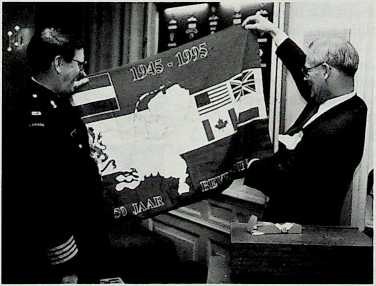
Following the opening of “De Bevrijders” exhibition on 5 April 1995, the chairman of the Airborne Museum Foundation, drs. J.W.A.M. Verlinden, presents Canadian military attache Colonel F.K. Laforge with a “50 jaar bevrijding” (50 years liberation) flag.
(photo; Berry de Reus)
Excursion to Germany
In connection with the 50th anniversary of the liberation of the Netherlands, the Society of Friends of the Airborne Museum is organising an excursion this year to the area around Hamminkeln in Germany.
The 6th British Airborne Division’s landings on 24 March 1945 will be the central theme of this trip which will take place on Saturday 27 May 1995. Attention will also be given to the landings by the 17th U.S. Airborne Division as well as to the Rhine Crossing operations at Wesel.
The programme is as follows.
09.00 departure by coach from the car park in front of the Goede Herderkerk (Good Shepherd church, next to the Kleyn Hartensteyn Brasserie), Utrechtseweg, Oosterbeek.
10.00 arrival in Hamminkeln. Coffee and showing of the documentary film “Operation Varsity”.
11.00 start of the excursion in the Hamminkeln and Wesel areas.
13.00 lunch.
14.00 continuation of the excursion.
16.00 start of return journey to Oosterbeek. 17.00 arrival in Oosterbeek.
The trip will be under the guidance of Mr. J. Nitrowski from Hamminkeln who has made an in depth study of the airborne landings in this region. During the excursion explanations will be in German, possibly with English summaries.
The cost is f 62.50 which covers the coach excursion, coffee, lunch and a comprehensive, illustrated guide. There are only 50 places available on the coach so applications will be handled on a first come first served basis. Closing date for applica¬tions is 17 May so, if you’re interested, pay up quickly. The treasurer will inform the lucky (and unlucky) would-be excur¬sionists in plenty of time.
Why an excursion to Hamminkeln?
This year the management of the Friends’ Society is organising an excursion to the area near Hamminkeln in Germany where, on 24 March 1945, the last great airborne operation of the Second World War took place. There are two reasons for choosing this area as subject.
In the first place we would like to investigate with you how the planning and execution of this airborne operation attempted to avoid the mistakes made at Arnhem. Those who are familiar with the course of the Battle of Arnhem will, on studying “Varsity” – the airborne part of the operation – come across certain decisions. They may conclude that, had similar decisions been taken in September 1944, the outcome of Operation Market Garden might have been totally different.
The second reason concerns the fact that this year sees the 50th anniversary of the liberation of our country, and not everyone is aware how the progress of the military operations eventually led to this liberation. It is therefore interesting to visit the areas which played such an crucial role in these military operations.
Furthermore, the Netherlands was liberated in the spring of 1945 by troops operating out of the region that we shall be visiting. They were part of a huge military force under the command of General Dwight D. Eisenhower which, in a gigantic campaign with a front line stretching from the Black Forest to the Netherlands, liberated Europe from German oppression. No fewer than 9 Allied armies were involved in this operation and 87 divisions fought many bitter encounters.
At a time when we shall be commemorating our liberation it is worthwhile pausing and reflecting for a while on this great force of arms, and we can best do this through such an excursion.
(Chris van Roekel)
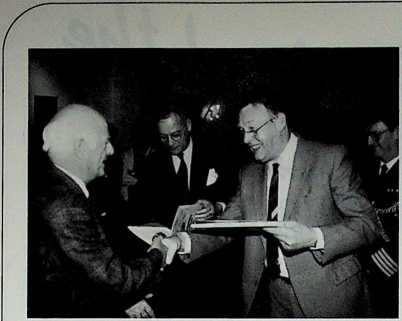
5 April 1995. Chris van Roekel, compiler of the Schools Project, hands over the first copies to the chairman of the Society of Friends, drs J. Smits (left), and to Mr. Verlinden, chairman of the Airborne Museum Foundation (centre).
(photo; Berry de Reus)
List of members
A list has been drawn up of members who responded to our call to send in their name and field of interest. The list is enclosed with this Newsletter. Those who would still like to be included on the list can simply write in to this effect.
Exhibition “De Bevrijders” (The Liberators)
On 5 April 1995 Colonel F.K. Laforge, military attache to the Canadian ambassador, opened the exhibition “De Bevrijders” (The Liberators) in the Airborne Museum “Hartenstein”.
The exhibits on display include uniforms and equipment of the various Allied army units that took part in the liberation of the Netherlands in the 1944/1945 period. Allied forces from the United States of America, Canada, Great Britain, Poland, Belgium, France, the Netherlands and Norway fought on Dutch soil from 12 September 1944 until 5 May 1945. More than 13,000 servicemen sacrificed their lives for our freedom.
The exhibition at the Airborne Museum lasts until 31 October 1995.
Revised Schools Project presented
The opening of the “De Bevrijders” exhibition coincided with the presentation of the first copy of the revised Schools Project by the Society of Friends of the Airborne Museum. The presentation was made by Mr. Chris van Roekel, the man behind the project, who handed over the first copies to the chairmen of the Airborne Museum Foundation and our society.
The revised schools project was made possible with the aid, in part, of the profits from the telephone card action held last year by the regional tourist board: “VW Arnhem, de Zuid-Veluwe & de Liemers”.
Gift of extraordinary press reports
The Airborne Museum “Hartenstein” has been given a number of original typed and handwritten press reports from the Battle of Arnhem.
For 50 years they had been in the possession of the veteran Mr. Butcher, who was a telegraphist in September 1944 attached to the Public Relations Team which went to Arnhem with the 1st British Airborne Division.
Mr. Butcher handed the reports over to his host Mr. Krijger from Oosterbeek while in Arnhem in September 1994 to attend the commemorations. Mr. Krijger in turn passed them on to the Airborne Museum.
The press reports were written by correspondents Alan Wood, Marek Swiecicki and Guy Byam. Before the reports could be transmitted to England they had to be passed by the censors, Captain Brett and
Lieutenant Williams. Their signatures appear on the reports together with the note “Passed for Publication”.
The press reports now reside in the archives of the Airborne Museum.
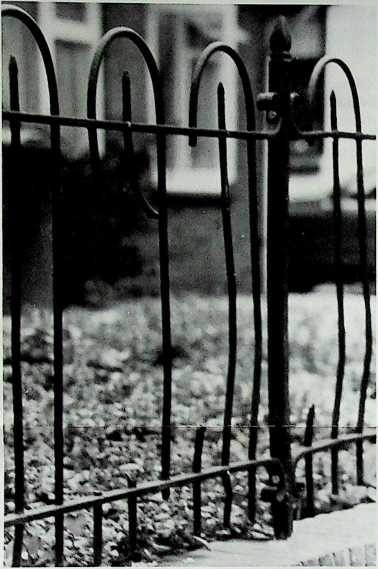
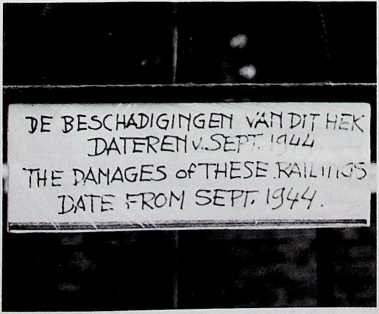
During the recent September commemorations an inhabitant of the Beneden-Weverstraat in Oosterbeek attached, alas temporarily, a little plate with explanatory text to his war-damaged gate.
(photos; Robert Voskuil)
In memoriam: Marek Swiecicki
Former war correspondent Marek Swiecicki has died in the United States; he passed away on 11 August 1994.
He was the author of the first ever book to be written about the Battle of Arnhem. It was entitled “With the Red Devils at Arnhem” and was published in November 1944. The book, for which Major-General R.E. Urquhart wrote the foreword, very soon appeared in Polish and Dutch versions. The latter was called “Roode Duivels in Arnhem”.
Swiecicki was born in Odessa in 1915 and grew up in the eastern Polish province of Wolyn. On completion of his studies at the University of Warsaw in 1937 he found employment with the Polish Telegraph Agency. He was in Paris at the outbreak of the Second World War.
He joined the Polish army in France, but when that country fell he made his way to Britain where he then worked for the Polish department of the BBC. As a correspondent with the exiled Polish Ministry of Information in London he was a member of the Polish liaison team at the headquarters of the 1st British Airborne Division. On the 18th of September 1944 he landed by glider to the west of Wolfheze. He quickly settled in at the Hartenstein hotel which became the operational base for his daily activities as war correspondent.
After the Battle of Arnhem Swiecicki worked as a press officer for General Anders, commander of the Polish 2nd Corps inTfaly. He accompanied units of the 1st British Airborne Division when they went to Norway in May 1945.
Following his demobilisation he worked first as editor of the “POLISH DAILY” newspaper in London and then as a journalist for Radio Free Europe. He emigrated to the United States in 1950 where he was employed in the Polish section of the “Voice of America” radio station. He had his own programme there until his retirement in 1993.
(George F. Cholewczynski)
Annual glider landings on video
“On The Same Spot” is the title of a new video film recording the landing of gliders during the last five commemorations of the Battle of Arnhem.
The first such flight took place on 22 September 1990 on the initiative of Mr. Luuk Buist from Oosterbeek, the aim being to commemorate the role of the Glider Pilot Regiment during the September 1944 hostilities. On 22 September 1990 two former glider pilots were flown from Terlet airfield near Arnhem to their original landing zones at Wolfheze by members of the local gliding club. Spectators and participants were so enthusiastic about this inaugural flight that it was decided to repeat the event each year up to and including 1994.
The film shows the preparations, the flight and the gliders landing on the zones at Wolfheze. It contains excellent ground and aerial shots.
The procession of old army vehicles carrying veterans to the landing zones also receives wide coverage, as does the wreath-laying ceremony at the Wolfheze monument on 14 September 1994. Sadly the glider part of the event had to be cancelled last year because of the atrocious weather conditions. The film also contains many authentic scenes from September 1944.
“On The Same Spot” was produced by Joop Bal and Luuk Buist. The film lasts thirty minutes, is available in both Dutch and English and can be obtained in the UK by sending £ 20 cash (no cheques) to; Bal Bedrijvsvideo, Rozensteeg 1, 6862 DH, Oosterbeek, The Netherlands.
St. Elisabeths Gasthuis in Arnhem closed
After almost 100 years the most famous hospital in Arnhem, the St. Elisabeths Gasthuis, closed its doors for the last time on 22 February 1995.
During the Battle of Arnhem, when it found itself in the middle of fierce fighting, it became one of the most important of the military hospitals. The 16th Parachute Field Ambulance had already installed itself there by the evening of 17 September 1944, and in the days that followed hundreds of wounded British and German soldiers and Dutch civilians were admitted.
It is not yet known what the future use of the building will be.
“Churchill’s Volunteer”
Reg Curtis is a well-known personality within the British Arnhem veterans group. He is a virtual ever-present at the annual commemoration of the Battle of Arnhem.
He has now written an account of Iris military career – which involved more than just “Arnhem” – and this has recently been published under the title “Churchill’s Volunteer – A Parachute Corporal’s Story”.
Reg Curtis joined the Grenadier Guards in 1937. Fie fought in France in 1940 and was among those who managed to escape from the beaches of Dunkirk. Back in England he volunteered for the Para Commandos, which entailed rigorous training often including extremely realistic military exercises. In November 1942 he went with the 1st Parachute Brigade to North Africa, where much bitter fighting took place at many locations. This was followed by the airborne landings on Sicily on 13 July 1943. In November 1943 his unit returned to his home country via North Africa, and back in England the 1st British Airborne Division began training for the invasion of Europe.
On 17 September 1944 he landed near Arnhem with tire 1st Parachute Battalion. The following day he received a serious leg wound during heavy street fighting in the western suburbs of Arnhem. He was taken to the emergency hospital set up in the Tafelberg hotel in Oosterbeek and there he remained for the rest of the battle. Curbs eventually ended up in a prisoner-of-war camp in Germany following stays in the St. Elisabeths Gasthuis in Arnhem and various hospitals in Apeldoorn. He was liberated by the Americans in 1945.
All these episodes have been described by Curtis in a lively manner, with a good eye for detail, and not without humour.
“Churchill’s Volunteer” contains 335 pages and includes photographs, drawings and appendices. It is published by Avon Books, 1 Dovedale Studios, 465 Battersea Park Road, London SW11 4LR and costs £ 14.95 exclusive of postage and packing.
Telephone cards highly valued by collectors
In 1994 the regional tourist board “VW Arnhem, de Zuid-Veluwe & de Liemers”, in combination with the Airborne Museum “Hartenstein”, issued a set of 4 telephone cards with “The Battle of Arnhem” as their theme.
Since then they have been chosen as no. 2 on the list of the Netherland’s most attractive telephone cards by the Dutch Telephone Card Club. Number one was a card showing the KLM aircraft the “Diver”.
A total of 900 “Battle of Arnhem” cards were issued in the Netherlands in 1994 and the Airborne Museum still has a few sets in stock. They cost 50 guilders per set.
Will “Who was Who” be reprinted?
In 1992 our society published the book “WHO WAS WHO during the Battle of Arnhem – The Order of Battle of airborne officers who fought at Arnhem in 1944”.
Tins reference work contains pertinent information on all 1st British Airborne Division and 1st Polish Independent Parachute Brigade Group officers.
Since its initial publication the compiler, Chris van Roekel, has thrice provided interested parties with lists of additions and corrections, but these lists of errata have not made the publication any easier to consult.
Partly because of this, and partly because the book is now sold out, the management is considering issuing a completely revised edition of ‘Who was Who’. To this end it is important that possible devotees let us know, in writing, whether or not they would be interested in such a reissue.
If you are interested drop a line to the society secretary through our British representative. The management will come to a decision on a possible reprint of ‘Who was Who’ based on the response.
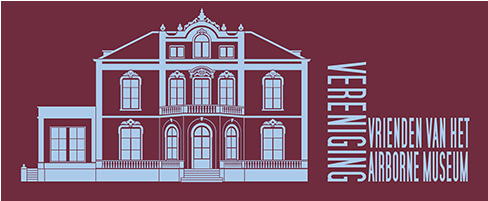
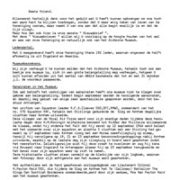
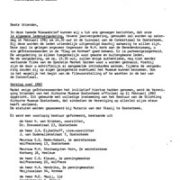
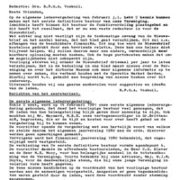
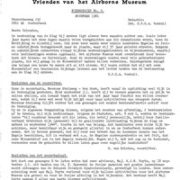
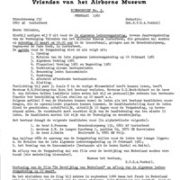
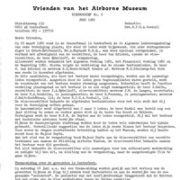
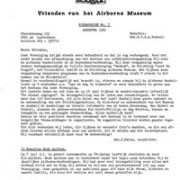
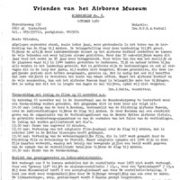
Plaats een Reactie
Vraag of reactie?Laat hier uw reactie achter.